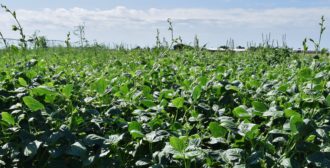EDINBURG, Texas- Known for their ability to produce nitrogen, legumes actually partner with rhizobium bacteria to create or fix nitrogen through specialized organs in their roots called nodules.
This unique relationship adds nitrogen back to the soil so it can be used as fertilizer by future crops.
In the Rio Grande Valley of Texas, researchers were working with a local organic farm to run a 14-acre cover crop trial when they noticed something troubling.
“At the end of the cover crop season, we went in and were checking the legumes. None of them had any nodules,” said Stephanie Kasper, a graduate student at the University of Texas Rio Grande Valley.
“It was a really big surprise to us. We thought if we plant legumes and inoculate them with the right rhizobia, it just works. They should fix nitrogen,” said Kasper.
Determined to find answers, Kasper applied for a Southern Sustainable Agriculture Research and Education (SSARE) Graduate Student Grant. Through the grant, she tested water stress, phosphorus availability, soil nitrogen, micronutrients, and native soil microorganisms to determine the likely causes of nitrogen fixation failure.
She used Iron and Clay cowpea, a legume widely used in South Texas for its drought tolerance, as the test plant.
To test the impact of water on nodulation, plants were watered at high, medium and low levels. Low levels simulated drought conditions while high levels saturated the soil.
Although tested separately, nitrogen and phosphorus levels were examined by adding a low and high rate of each nutrient with a control group receiving none.
Micronutrient testing was conducted in two ways. First, all micronutrients were added together. In a separate test, plants were grown in a grow chamber and received one micronutrient while all others remained the same.
Using an autoclave, a soil sterilization test isolated the impact of soil microbes on nodulation by sterilizing the soil used for some plants while those in the mycorrhizae test group received one milliliter of mycorrhizal inoculant solution at planting.
All plants were grown for 75 days in a greenhouse.
At harvest, five plants from each group were randomly selected. Roots were cleaned and the nodules counted then weighted.
Internal color was checked as an indicator for nitrogen fixation. Pink or red nodules are actively fixing nodules, while green, brown or grey do not fix nitrogen.
Plants were dried, weighed and the data was analyzed.
The results showed that soil moisture and micronutrients have an impact on a plant’s ability to produce nodules.
Increased soil moisture improved nodulation, but according to Kasper, when they receive water has a larger impact on nodulation.
“During the course of the plant's lifetime, it is most important that it has moisture during the beginning of the season, when it's first starting to grow and it has the opportunity to form the relationship with the bacteria. If it is dry during the beginning of the season, and the relationship between the plant and bacteria doesn’t form because there isn’t enough moisture in the soil, then you probably won’t see nitrogen fixation even if you get water later," said Kasper.
The first micronutrient test showed a 79% increase in nodulation over the control but during follow-up experiments, the increase was not observed. While more research needs to be conducted, the data does suggest that micronutrients play a role in a plant’s ability to fix nitrogen.
“In the first experiment, we added multiple micronutrients at once. To give good advice to our farm partners, we wanted to know if it was all six of those micronutrients or if you could just add one or two of them,” said Kasper.
In the original testing, the plants were grown in a greenhouse. The second test was conducted in a growth chamber which helps plants by eliminating some stress factors and controlling the environment to promote growth.
One of the roles of micronutrients is to help plants mediate stress. If plants are under less stress, they rely less on micronutrients. This could explain the differences between the two tests.
Phosphorus, nitrogen and mycorrhizae fungi were all eliminated as potential explanations for nodular failure.
While high nitrogen levels can inhibit nodule formation, they do not support the idea that nitrogen is the primary driver in nodule failure because lower nitrogen levels did not increase in nodulation.
Nodule biomass and intensity were not significantly higher or lower with any tested amount of phosphorus and while other studies have suggested the mycorrhizal inoculation can improve nodulation, this study did not confirm this and removed it as an explanation for the fixation failure.
The impact of native soil microbes is unclear. While plants in sterilized soil had significantly reduced nodule biomass than those in unsterilized soil, researchers suggest that a better understanding of the ecology of microbial communities is needed to maximize the impact of cover crops and overall soil health.
While further testing is needed, this research helps develop more sustainable farms by increasing our understanding of legumes and the factors that impact nitrogen fixation.
Published by the Southern Region of the Sustainable Agriculture Research and Education (SARE) program. Funded by the USDA National Institute of Food and Agriculture (NIFA), Southern SARE operates under cooperative agreements with the University of Georgia, Fort Valley State University, and the Kerr Center for Sustainable Agriculture to offer competitive grants to advance sustainable agriculture in America's Southern region. This material is based upon work that is supported by the National Institute of Food and Agriculture, U.S. Department of Agriculture, through Southern Sustainable Agriculture Research and Education, under sub-award number: GS18-193. USDA is an equal opportunity employer and service provider. Any opinions, findings, conclusions, or recommendations expressed in this publication are those of the author(s) and do not necessarily reflect the view of the U.S. Department of Agriculture.
Want more information? See the related SARE grant(s) GS18-193, Investigating Controls Over Nodulation and Nitrogen Fixation in Leguminous Cover Crops in Subtropical South Texas
